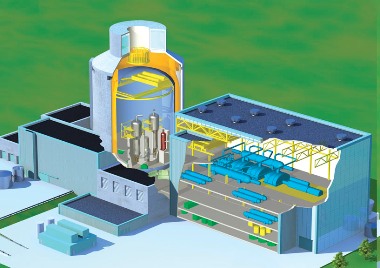 |
| AP1000 |
American nuclear safety regulators have approved an amendment to the AP1000 reactor design, in a major step towards US deployment of the model. Construction on new reactors could begin very soon.
The issuance of the final ruling was the major outstanding prerequisite before the Nuclear Regulatory Commission (NRC) will be able to grant licenses to construct and operate AP1000 power plants. This is expected shortly for two separate projects, each envisaging two AP1000 units: Vogtle 3 and 4 in Georgia, under the management of Southern Nuclear; and South Carolina Electric & Gas's (SCE&G's) VC Summer 2 and 3.
Groundwork for both projects began over two years ago, when the NRC approved their siting. Both sites now feature many non-nuclear plant structures, such as water intake piping, module assembly areas and derricks for the huge cranes that will lift modules into place. Major components are at various stages of readiness in the supply chain, a simulator has been installed at Vogtle and fuel supply has been contracted.
The official start of construction for a nuclear power plant is the pouring of the first concrete for structures related to nuclear safety. This cannot happen until licenses are issued by the NRC.
Southern has been told it may receive its licenses before the end of this year, while SCE&G's may come early in 2012. When they come, Southern and SCE&G said, their projects should begin in earnest and employ up to 3500 each during the construction phase.
Yesterday's design certification concerned an amendment to the AP1000 design, which had already been certified in 2006. Changes to that design were made to meet new requirements from the NRC, including the ability to withstand an aircraft impact on its shield building. Westinghouse had to worke very hard to achieve this due to the lack of international codes for the steel-concrete-steel sandwich construction of its buildings. The sandwich technique had also been flagged as a potential issue for UK deployment, but this was resolved with regulators and the AP1000 has been granted the interim design acceptance certificate. Some regulatory work remains to be finalised when Westinghouse has a committed UK customer with a specific site.
Meanwhile in China there are already four AP1000s under construction at Sanmen and Haiyang, the first of which should generate power in 2013. These use the original design for the buildings, although forthcoming ones are to use the later specification and would therefore match future UK and US units. China plans many more AP1000s with different degrees of involvement from Westinghouse and its partner, Shaw, gradually increasing the leadership of domestic companies and engineers.
Researched and written
by World Nuclear News




_18570.jpg)
_16159.jpg)
_18938.jpg)
_33584.jpg)





